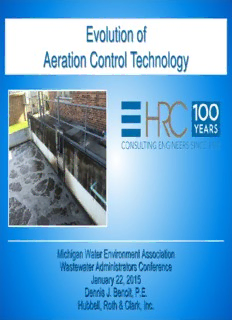
Evolution of Aeration Control Technology PDF
Preview Evolution of Aeration Control Technology
Evolution of Aeration Control Technology Michigan Water Environment Association Wastewater Administrators Conference January 22, 2015 Dennis J. Benoit, P.E. Hubbell, Roth & Clark, Inc. Outline Why Control Aeration Equipment? Instruments Utilized Methods of Control Current Approach Control Technology Large plants Small plants Examples Why Control Aeration Equipment? Energy Costs $$$$$$$$ Typically 40-60% of WWTP Total Energy Usage Biological Control Too Much Air - Poor Settling Too Little Air - Dead Bugs, Poor Settling Controlled Aeration = Happy Bugs Why Do Dissolved Oxygen Levels Vary? Diurnal Fluctuation in BOD and Ammonia Load Photosynthesis / Respiration effects Variable Sidestream Loads Variable Oxygen Uptake due to Seasonal Environmental Conditions (Temperature, etc.) Instruments Utilized Dissolved Oxygen Probes Historically Membrane Type Prone To Erroneous Readings and Malfunctions Frequent Recalibrations Optical Multi-function Probes Can Monitor DO, ORP, Turbidity Some Need Air Cleaning Pipeline Mount Models Wireless Models Optical Probe Accuracy Off Gas (Oxygen Uptake Rate) Off Gas or Uptake Rate Measurements Monitors DO in Off-gas Rather than in Mixed Liquor (I.E. Respiration Rate) Measures Biological Activity -- not just the Environmental Conditions More Akin to a “Heart Rate Monitor” Methods of Control Mechanical Aeration Change Levels with Control Weir Change Device Speed Weir Can be Automated to Provide Some Control Diffused Aeration Control Air Distribution within Tank Diffuser Distribution / Density Drop Throttling Control Air Volume Blower Inlet Throttling Variable Speed Blowers Mechanical Aeration Three Primary Types Horizontal Brush Rotors / Oxidation Ditch Vertical Rotors Hybrids Horizontal Mechanical Aeration Horizontal Brush Rotors / Oxidation Ditch Change Levels with Control Weir Limited Aeration Control and Operational Flexibility Weir Can Be Automated to Provide Some Control Rotors Can Work with Variable Speed (More Commonly with Belt Drive) Oxygen Input Location is Concentrated Limited Potential for Nutrient Removal (Anaerobic/Anoxic/Oxic Zones)
Description: